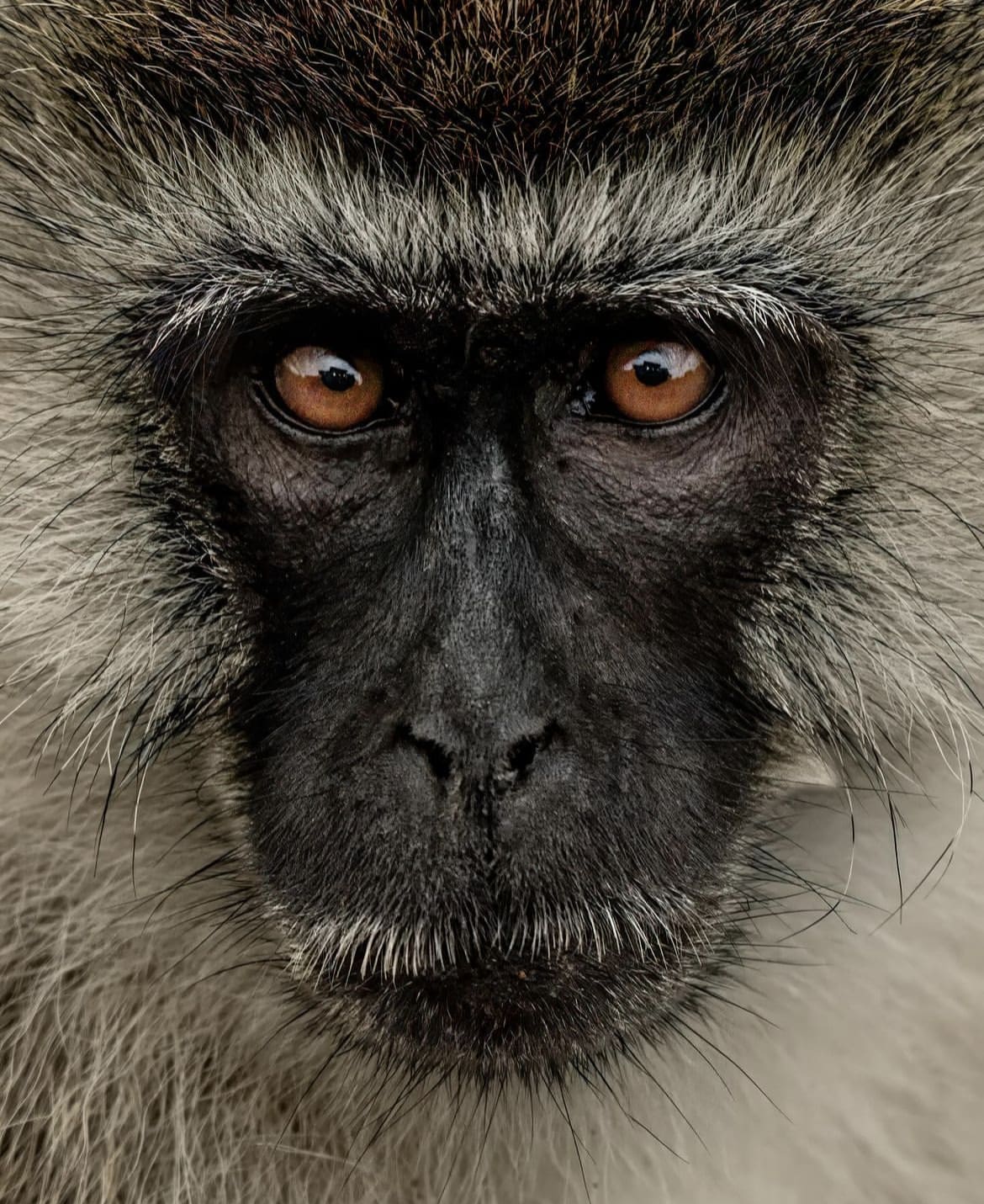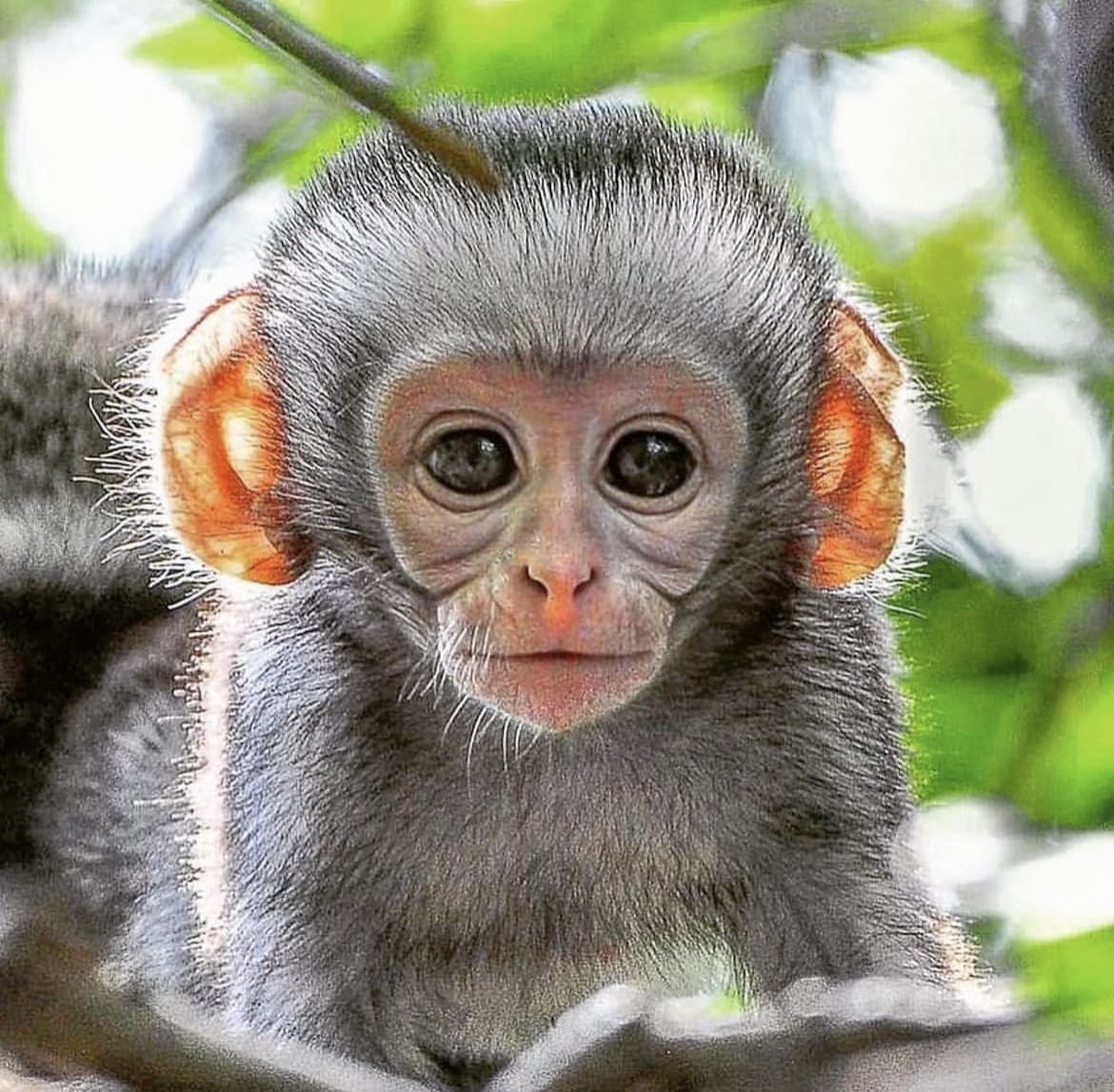Imagine you’re chilling in the African savannah, and you spot this small, greyish animal with a black face chilling in the trees. That’s your introduction to the Vervet Monkey, a key player in Africa’s ecosystem and a monkey that’s as fascinating as your favorite Netflix drama.
What is the Vervet Monkey?
These guys aren’t just any random primates; they’re a part of the fabric that makes up the African wilderness. Scientifically, they’re known as Chlorocebus pygerythrus, which might sound like a spell from Harry Potter, but it’s just science speak for a really interesting species of monkey that’s found all over Eastern and Southern Africa.
They’ve been the subject of countless studies, thanks to their complex social structures, communication skills, and, frankly, because they’re just so damn interesting to watch.

What Do Vervet Monkeys Look Like?
Picture this: a medium-sized monkey with a grin that looks like it knows the punchline to a joke you haven’t heard yet. Vervet Monkeys are the epitome of the phrase “dressed to impress,” with their silver-grey fur and a stylish black face that stands out in the African bush.
But it’s not just about looks with these creatures. They have this cool, laid-back vibe, but they’re ready to leap into action at a moment’s notice. Their tails are longer than their bodies, which is pretty handy when you’re trying to balance on a thin branch or make quick getaways from predators. And their expressive faces? They’re not just for show, these monkeys use them to communicate with each other.
How Big Are Vervet Monkeys?
Vervet Monkeys are like the compact cars of the primate world—small enough to be agile, but with enough room to pack a punch. Males typically hit the scales at around 5.5 to 8 kg (that’s about 12 to 17 pounds for those of us who don’t do metric), while the females are a bit lighter, usually weighing in at 4 to 5.5 kg (around 8.8 to 12 pounds).
To put it in urban terms, they’re the size of a large house cat or a small dog, but with way more attitude. They’re not going to win any heavyweight championships, but in the dense forests and savannahs of Africa, being light and nimble is what keeps you alive.
Vervet Monkey Skin
The skin of a Vervet Monkey isn’t just your average monkey skin. These critters sport a tough exterior that’s adapted to the sometimes harsh African environment. It’s like they’re wearing a natural suit of armor, except it’s much cooler and doesn’t weigh them down.
Their skin, particularly on their faces and other exposed areas, is black, which is not just a fashion statement but a practical adaptation. Think about it – the black skin reduces glare from the sun, which is pretty handy when you’re living under the African sun and need to spot a predator or some tasty fruit from a distance.

Vervet Monkey Legs
When it comes to getting around, Vervet Monkeys have the game figured out. Their legs are built for a life spent both in the trees and on the ground. They’re the ultimate all-terrain vehicles of the primate world. The back legs, stronger and longer, give them the power to leap between branches or sprint across the ground when they need to make a quick escape or chase down a meal.
But it’s not just about power. Their front legs are nimble, perfect for grooming their pals or picking fruit with the precision of a seasoned chef. It’s this combination of strength and agility that allows them to move with the confidence of a tightrope walker, whether they’re navigating the dense canopies or the forest floor.
Vervet Monkey Colouration
Talking about their style, the Vervet Monkey’s colouration is not just about looking good; it’s about survival. Their fur, a sleek silver-grey, blends perfectly with the African bush, making it harder for predators to spot them. It’s the ultimate camouflage, allowing them to chill in the treetops or forage on the ground without becoming someone’s snack.
It’s the little touches that really set them apart. The darker fur on their limbs and tails, the white belly, and that distinctive black face with white-fringed hair – it’s all about sending signals. Whether it’s attracting a mate or warding off rivals, their colouration plays a crucial role in their social interactions. It’s like wearing the right outfit to a party; it tells everyone who you are and what you’re about.
What Do Vervet Monkeys Eat?
Dive into the culinary world of the Vervet Monkey, and you’ll find they’re not picky eaters. These guys are the ultimate food critics of the African savannah, with a diet that’s as varied as the latest hipster cafe menu. From tender young leaves to juicy fruits, they’ve got a palate that appreciates the finer things in life. And let’s not forget the occasional insect or bird egg for that protein kick. It’s like they’re following the latest flexitarian diet trend, but, you know, naturally.
Here’s where it gets interesting: Vervet Monkeys are also known to raid crops and swipe food from unsuspecting tourists. It’s not exactly polite dinner etiquette, but it shows how adaptable they are. They’re the opportunists of the animal world, always on the lookout for a free meal, showcasing their intelligence and resourcefulness.

Vervet Monkey Social Structure
Ever watched a reality TV show and thought, “This drama is too much”? Well, the social life of Vervet Monkeys could give those shows a run for their money. They live in highly organized groups, sometimes numbering up to 50 individuals, complete with all the alliances, betrayals, and soap opera-worthy drama you can imagine.
At the heart of their society is a strict hierarchy, with dominant males at the top and females forming the backbone of the social structure. Females typically stay with their birth group for life, creating strong familial bonds and a matriarchal vibe that ensures the group’s stability and survival.
What’s fascinating is how they communicate – from intricate vocal calls that warn of predators to subtle body language that indicates mood and intention. It’s like they have their own social media network, except it’s all done face-to-face, or should we say, snout-to-snout.
How Do Vervet Monkeys Reproduce?
In the world of Vervet Monkeys, love (or something like it) is always in the air. Their mating season brings all the boys to the yard, so to speak, with males displaying a variety of behaviors to attract the attention of females. From strutting their stuff to showing off their fighting prowess, it’s all about proving who’s the most eligible bachelor.
Once a pair hits it off, gestation lasts about 5 to 6 months, culminating in the birth of a single infant. These little ones are the center of attention, with the entire troop playing a role in their upbringing. It’s a real community effort, showcasing the deep social bonds that Vervet Monkeys form.
The early years are crucial, with infants learning the ropes of monkey life through play and observation. It’s during this time that they learn essential survival skills, like what to eat, how to communicate, and the art of navigating their complex social world. It’s like monkey kindergarten, but with life-or-death stakes.

How Long Do Vervet Monkeys Live?
The life of a Vervet Monkey isn’t just about swinging from trees and munching on fruit; it’s a journey with its own set of challenges. In the wild, these resilient critters can live up to 12 years, a testament to their adaptability and survival skills. But when they’re under human care, away from predators and with a steady diet, they can hit the ripe old age of 24. It’s like comparing a rough-and-tumble street artist to a pampered gallery superstar. Both are thriving in their own worlds, but the care and environment make a huge difference.
This longevity in the wild is remarkable, considering the hazards they face, from eagles swooping down for a quick snack to snakes that see them as the perfect meal. It’s a testament to their wits and agility, not to mention the protective eye of their troop members. In Vervet society, everyone looks out for each other, proving that there’s strength in numbers.
Are Vervet Monkeys Aggressive?
Let’s address the elephant in the room, or rather, the monkey. Vervet Monkeys have a bit of a rep for being feisty, especially when they feel threatened or their territory is invaded. But it’s not like they’re out there looking for a fight. Their aggression is more about communication, a way to establish boundaries and social order within the troop.
When it comes to humans, they’re curious but cautious. Those tales of Vervets snatching food from picnics? It’s not aggression; it’s opportunism, mixed with a dash of cheekiness. Sure, they might get a bit bold if they think they can nab a free lunch, but wouldn’t you?
However, within their own communities, disputes are usually settled with some posturing and the occasional scuffle. It’s more about showing who’s boss than causing serious harm. Think of it as the monkey version of a heated debate, complete with shouting and dramatic gestures.
Are Vervet Monkeys Territorial?
Absolutely, but it’s all about location, location, location. Vervet Monkeys have their favorite hangouts – those prime spots with the best food sources and comfy sleeping trees. They’re not about to let any Tom, Dick, or Harry of the monkey world waltz in without a fuss.
Their territory is their home, their supermarket, and their playground, all rolled into one. And they defend it with a mix of vocal alerts, threatening displays, and, if push comes to shove, a bit of physical persuasion. But it’s not just about keeping intruders out; it’s about keeping their community safe and secure. After all, in the harsh landscapes of Africa, a good home base is worth its weight in bananas.

How Fast Are Vervet Monkeys?
Ever wondered who could win in a race, you or a Vervet Monkey? Put your money on the monkey. These agile creatures are the Olympians of the tree canopy and the savannah, capable of reaching speeds that would make a sprinter envious, all while navigating a complex three-dimensional environment. Whether it’s dashing across the ground to escape a predator or swinging through the trees with the grace of a gymnast, Vervet Monkeys have speed and agility down to an art.
Their quick reflexes aren’t just about speed for the sake of it; it’s survival. Being able to bolt at the first sign of danger or chase down a fleeting meal is what keeps them one step ahead of the game. It’s a high-stakes world out there in the wild, and speed is one of the Vervet’s best defenses.
Where Do Vervet Monkeys Live?
Vervet Monkeys aren’t picky about their address. These versatile primates have made themselves at home across a wide range of habitats, from the lush forests to the arid landscapes of Eastern and Southern Africa. They’re as comfortable in the leafy branches of a forest canopy as they are foraging on the ground in open savannahs. It’s this adaptability that has allowed them to thrive in a variety of environments, making them one of the most widespread monkey species on the continent.
Their homes are more than just a place to sleep; they’re a community hub. Vervet Monkeys are highly social creatures, and their living spaces are carefully chosen to provide safety, food, and the perfect playground for their young. Whether it’s a cozy nook in the trees or a sunny spot on the savannah, home is where the troop is.

How Many Vervet Monkeys Are There in the Wild?
Counting Vervet Monkeys is a bit like trying to take a headcount at a rock concert; they’re always on the move, and there’s a lot of them. But estimates suggest that their numbers are robust, thanks in part to their adaptability and versatility. They’re not currently considered endangered, but like all wildlife, they face threats from habitat loss, hunting, and human encroachment.
Their ability to thrive in a variety of habitats has been a boon, allowing them to maintain stable populations even as their natural environments are under pressure. However, it’s a delicate balance. Conservation efforts and sustainable land management are crucial to ensuring that Vervet Monkeys continue to play their vital role in the ecosystem.
Are Vervet Monkeys Endangered?
Despite being adaptable and widespread, Vervet Monkeys do face their share of troubles. They’re currently not listed as endangered, which is great news, but don’t let that fool you into thinking everything’s peachy. Their resilience masks underlying issues like habitat destruction, conflict with farmers, and the illegal pet trade, all of which threaten their long-term survival.
It’s a bit like living in a bustling city where the neighborhoods are constantly changing. Vervet Monkeys have to navigate an ever-shifting landscape where their natural habitats are being transformed by human activity. Conservation efforts are in place, aiming to protect these primates and their habitats, ensuring they remain a common sight in the African wilderness. It’s about finding that sweet spot between human development and wildlife conservation, a challenge for sure, but not insurmountable.
Threats to Vervet Monkeys in the Wild
In a world where forests are shrinking and farmlands expanding, Vervet Monkeys find themselves on the front lines of the human-wildlife conflict. It’s not an action movie plot; it’s reality. Habitat loss is a significant threat, pushing these monkeys into closer contact with humans, leading to conflicts, especially when they raid crops in their quest for food. Then there’s the issue of being hunted for bushmeat or captured for the illegal pet trade, both of which pose serious risks to their populations.
But Vervet Monkeys are fighters, adapting to changing environments and finding new ways to survive. They’re the ultimate survivors, showcasing an incredible ability to live alongside humans, albeit not without its challenges. The key to their future? A balanced approach to conservation that addresses both the needs of these monkeys and the communities they come into contact with.

Where to See Vervet Monkeys
Fancy a safari that’s not just about the big five? Vervet Monkeys can add that extra bit of magic to your African adventure. They’re found in many national parks and reserves across Eastern and Southern Africa, offering plenty of opportunities for wildlife enthusiasts to observe these fascinating creatures in their natural habitats.
Kruger National Park in South Africa, Serengeti National Park in Tanzania, and Amboseli National Park in Kenya are just a few spots where you’re likely to see these agile primates doing their thing. Whether they’re foraging, playing, or just lounging around, Vervet Monkeys are a testament to the beauty and diversity of African wildlife.
So, grab your binoculars and keep your eyes peeled. Watching a troop of Vervet Monkeys in action is an unforgettable experience, offering insights into their complex social structures and behaviors. It’s a reminder of the wonders that nature holds and the importance of preserving these for future generations.
Tips for Spotting Vervet Monkeys
So, you’re keen on meeting these mischievous characters up close and personal? Spotting Vervet Monkeys is an art and a science, mixed with a bit of patience and luck. Here are some pro tips to increase your chances of a memorable encounter:
- Early Bird Gets the Worm: These primates are most active in the early mornings and late afternoons, so set that alarm clock or stick around as the day cools off.
- Look Up and Look Around: While Vervet Monkeys spend time on the ground, they’re also adept climbers. Scan the trees and listen for the rustling of leaves.
- Follow the Noise: Their social nature means they’re often quite vocal. Their calls can lead you right to them, so tune your ears to their chatter.
- Stay Near Water: Vervet Monkeys, like many animals, need to drink, making water sources a prime spot for sightings.
- Keep It Respectful: Remember, you’re in their home. Keep a safe distance, don’t feed them, and avoid making loud noises or sudden movements.

Facts about The Vervet Monkey
- Masters of Communication: Vervet Monkeys have a sophisticated system of vocal calls that can specify different predators, effectively acting as their own language.
- Alcoholic Tendencies: In studies, these monkeys have shown a preference for alcohol, stealing fermented sugarcane drinks from locals.
- Color Vision: Unlike many mammals, Vervet Monkeys have excellent color vision, which helps them select ripe fruits and leaves.
- Cultural Learners: They learn from each other, passing down knowledge across generations, such as the best ways to use tools or find water.
- Medicinal Knowledge: They’ve been observed eating specific plants that act as medicinal remedies for various ailments.
Myths about The Vervet Monkey
- Monkeys as Pests: While they can raid crops, Vervet Monkeys often only turn to farms when their natural food sources are scarce due to habitat loss.
- Aggression Myth: Their interactions with humans are often misinterpreted as aggressive when they’re usually driven by curiosity or the search for food.
- Pet Material: Despite their cute appearance, Vervet Monkeys make poor pets. They require complex social interactions and specific diets that can’t be met in a typical home setting.
- Simplicity: Many assume Vervet Monkeys lead simple lives, but their social structures, behaviors, and interactions are incredibly complex and nuanced.
Diving into the world of the Vervet Monkey reveals a narrative rich with intrigue, survival, and the complex beauty of nature’s design. From their sophisticated social structures to their ingenious survival tactics, Vervet Monkeys embody the resilience and adaptability of the animal kingdom.
Their story is a poignant reminder of the delicate balance between humans and wildlife, highlighting the importance of conservation and understanding to ensure these fascinating creatures continue to thrive alongside us.
